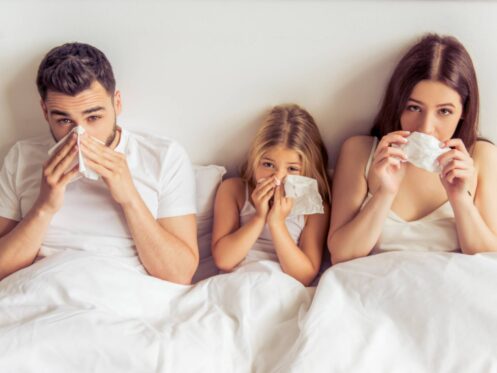Springtime in Las Vegas, NV brings warm temperatures, sunshine and beautiful flowers. This is a time of year when many people experience allergy symptoms, like sneezing, coughing and itchy eyes. Heading into your home for a break from pollen exposure can be beneficial. Unfortunately, many people have poor indoor air quality which can make matters worse. However, there are tips you can use to allergy-proof your home this spring.
1. Upgrade Your Air Filters
Consider the type of filter you’re using in your HVAC system. This filter is responsible for removing particulate matter from the air that’s moving through your system during the heating or cooling process. These filters usually need to be replaced every 30 to 90 days, which is an important part of maintaining healthy indoor air quality. Consider upgrading the type of filter you’re using. Pleated varieties have ample surface area that can trap particulates that are approximately 3 microns in size. This includes dust, mold spores, pollen and dust mite debris.
Many allergens are as small as 1 micron in size. You will likely need to upgrade your filter to trap these contaminants. Consider using the minimum-efficiency reporting value (MERV) scale to choose a filter option. The higher the MERV rating, the more particulate matter will be trapped. Most residential HVAC systems can handle a MERV rating between 8 and 12. Anything higher is likely too restrictive for your equipment. You can consult with our team to find out more about what kind of filter you should be using.
Consider using an activated carbon filter to remove particulates, volatile organic compounds and odors. Many filters combine more traditional filtration materials with activated carbon for a multi-step approach to healthy indoor air quality.
If you’re using a washable furnace filter, consider changing it to a replaceable version. Even with the best cleaning methods, it’s hard to remove all the particulate matter from a filter.
While you may be trying to find a cost-effective filter, it may be beneficial to invest a little more money in something that is better quality. More affordable filters may need to be replaced more frequently, which negates the savings.
2. Seal Air Leaks
It’s common for homes to have small holes and gaps that allow outside air in. Common areas of concern include your attic, basement foundation and around windows and doors. These spaces should be sealed using products like caulk and weather stripping. This will reduce the number of allergens in your home while promoting an efficient residence. You should see a decrease in your monthly energy consumption.
3. Use Whole-Home Air Purifiers
A whole-home air purifier can be installed onto your HVAC system to remove allergens and particulate matter from your indoor air. These units use enhanced filtration that’s different from what’s used in your furnace. For example, high-efficiency particulate air filters (HEPA) can remove up to 99.97% of particulate matter from your air. This type of filter poses too much airflow restriction when used in a furnace. They’re common in filtration equipment. Make sure you change your filter regularly to ensure your filtration equipment is working properly throughout allergy season and during the rest of the year.
4. Establish a Cleaning Routine
Cleaning your home removes allergens from surfaces, bedding and floors. Get into a routine during allergy season, wiping down countertops, tables, flooring and appliances. Clean your carpet using a vacuum that has HEPA filtration. This will stop the particulates from escaping the vacuum and entering your indoor air. Mop floors and change your bedding at least once per week.
5. Control Humidity Levels
The relative humidity in your home should always be between 35% and 50%, regardless of the season. Several factors can impact your home humidity level, including the weather outside, bathing, cleaning and cooking. We recommend that you use your exhaust fans located in your bathrooms and kitchen to remove some of this excess moisture. Ventilation equipment can also help.
You can invest in a whole-home dehumidifier to remove excess moisture from your indoor air. Very humid air can hold on to more particulate matter, increasing allergy symptoms. Humid air can also feel uncomfortable.
Las Vegas is known for very dry air. If you’re experiencing dry air in your home that’s leading to sinus irritation, this can make your allergies worse. You can use a whole-house humidifier to add some moisture back into your air.
Make sure that you monitor the relative humidity in your home and change between these units as necessary. Many smart thermostats are equipped with a hygrometer, which will provide real-time data regarding your humidity. You can use this device to control your dehumidifier and humidifier remotely.
6. Incorporate Household Plants
Several types of indoor plants can help remove toxins and other contaminants from your indoor air. This includes the peace lily, different varieties of ivy and aloe vera.
Make sure that you’re properly caring for your houseplants. They can experience mold growing in their soil and dust accumulating on their leaves. Don’t overwater your houseplants and gently wipe down their leaves as part of your cleaning routine.
7. Consider Your Allergy Routine
Think about the daily practices that may contribute to how allergy-proof your home is. For example, taking off your shoes when you come inside can prevent spreading pollen and other particulate matter throughout your home. You should also shower and put on clean clothes at the end of the day. This removes pollen and other allergens from your skin, hair and clothing.
Keeping pets out of your bedroom can provide you with a safe space that’s low in allergens. This allows your body to recharge and heal while you sleep, rather than experiencing more histamine reactions and a flare of symptoms.
If you want to open your windows and doors to let fresh air inside, do so when pollen levels are at their lowest. This is usually in the early morning hours or late in the evening.
Also, make sure that you’re keeping up with professional service for your HVAC system. This is an integral part of maintaining healthy indoor air quality during the allergy season. We recommend that you schedule a routine inspection annually prior to the start of spring. This will ensure the efficiency of your system without overworking your heating and cooling components. System strain can lead to catastrophic shutdowns of your HVAC system, which can drastically impact your indoor air quality during allergy season. Not to mention, this can result in costly repairs.
Bumble Breeze can help you maintain a healthy indoor environment throughout allergy season and beyond. We can provide routine maintenance that will keep your HVAC equipment running efficiently and effectively. Installing whole-home air purification and humidity-controlling equipment is also part of our services. We can also perform air duct cleaning to remove particulate matter and improve indoor air quality. Reach out to Bumble Breeze for indoor air quality assistance in Las Vegas today.


